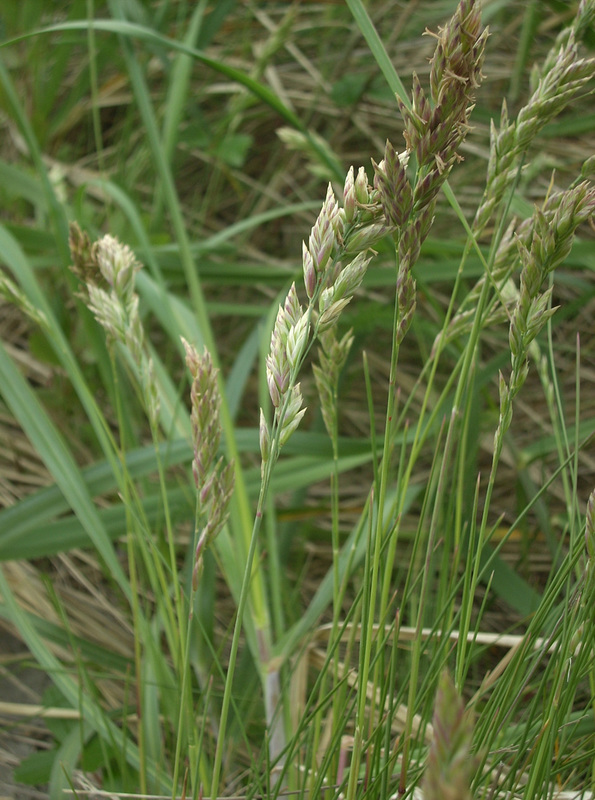Dune bluegrass, seashore bluegrass • Poa macrantha
|
Identification
Dune bluegrass is a perennial species with creeping rhizomes and runners (above ground, horizontal stems) that extend above and below the sand. This species is dioecious, and has hairless stems arising from tufts of stiff, inrolled leaves. Leaves can reach 3 mm in width, lack auricles, and are unique in having very hairy, long (1-1.5 mm), robust ligules. Spike-like clusters of compact panicles occur at the tops of stems, and and range in length from 4 to 12 cm. Spikelets are about 12 mm in length and each have five flowers. Another distinguishing characteristic of this species are the hairy lemmas (only on the keel) of the florets. See the E-Flora species page for further details. Habitat and Range Dune bluegrass grows on coastal sand dunes from southeast Alaska to northern California. It has a sporadic distribution, but can be common when habitat conditions are ideal. |
Similar Species
Little beach bluegrass (Poa confinis) is similar in growth form, habitat and distribution to dune bluegrass, but has shorter much panicles (1.5-4 mm) and lemmas (2-4 mm). Little beach bluegrass is also more slender than dune bluegrass. Eminent bluegrass (Poa eminens) may also be confused with dune bluegrass, however the former grows on gravel beaches and in salt marshes in more northern regions of BC from Kitimat and Douglas channel north throughout coastal Alaska.
Intriguing Information
Dune bluegrass is a very important dune stabilizing species, due to its extensive network of creeping rhizomes and runners.
Little beach bluegrass (Poa confinis) is similar in growth form, habitat and distribution to dune bluegrass, but has shorter much panicles (1.5-4 mm) and lemmas (2-4 mm). Little beach bluegrass is also more slender than dune bluegrass. Eminent bluegrass (Poa eminens) may also be confused with dune bluegrass, however the former grows on gravel beaches and in salt marshes in more northern regions of BC from Kitimat and Douglas channel north throughout coastal Alaska.
Intriguing Information
Dune bluegrass is a very important dune stabilizing species, due to its extensive network of creeping rhizomes and runners.
References
Poa marcantha Vasey. Dune bluegrass. In Klinkenberg, Brian. (Ed.). E-Flora BC: Electronic Atlas of the Plants of British Columbia. Lab for Advanced Spatial Analysis, Department of Geography, University of British Columbia, Vancouver. Accessed 2016-03-04
Pojar, J. and MacKinnon, A. (1994). Plants of Coastal British Columbia. Vancouver, BC: Lone Pine Publishing. P. 377.
Authors and editors of page
Bea Proudfoot and Kelly Fretwell (2016)
Poa marcantha Vasey. Dune bluegrass. In Klinkenberg, Brian. (Ed.). E-Flora BC: Electronic Atlas of the Plants of British Columbia. Lab for Advanced Spatial Analysis, Department of Geography, University of British Columbia, Vancouver. Accessed 2016-03-04
Pojar, J. and MacKinnon, A. (1994). Plants of Coastal British Columbia. Vancouver, BC: Lone Pine Publishing. P. 377.
Authors and editors of page
Bea Proudfoot and Kelly Fretwell (2016)




